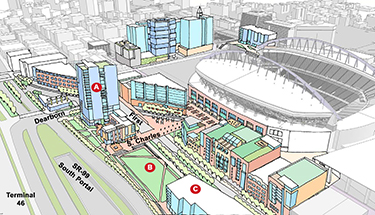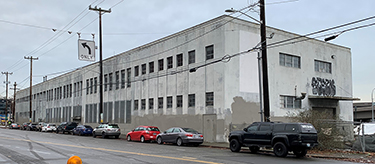|
Subscribe / Renew |
|
|
Contact Us |
|
| ► Subscribe to our Free Weekly Newsletter | |
| home | Welcome, sign in or click here to subscribe. | login |
Real Estate
| |
 Brian Miller Real Estate Editor |
January 5, 2023
On the Block: What will become of WSDOT's 4 acres in SoDo?
Down in SoDo near the stadiums, west of the Silver Cloud, is a vacant old warehouse/office building at 1051 First Ave. S. It was purchased by the state Department of Transportation over a decade ago, along with other adjacent property, for the viaduct replacement tunnel. Until recently, it served as the headquarters for the state's Alaskan Way Viaduct Replacement Program, which is gradually winding down.
That 83-year-old building is now deemed obsolete and unsafe, and WSDOT recently filed demolition plans for the structure. Anchor QEA is leading the effort, with no demo contractor yet attached. The building will be the second demolished from what most call the WOSCA Terminals property. Its absence will leave a vacant, roughly 4-acre strip between First and state Route 99 — i.e. the south tunnel portal — that has long been coveted by developers.
Once a cut-and-sew shop for Gerry Sportswear, the doomed building is on the corner of South Royal Brougham Way, and the property extends north to South Dearborn Street. If you walk that stretch, where First is gradually taking a new shape with fresh pavement, you'll notice less construction staging and more bare dirt.
Hard to believe after these many years, but our waterfront makeover is gradually nearing completion. WSDOT's involvement, including the Colman ferry dock and realignment of First, is supposed to wrap this summer. (A new bike/ped connector, just east of SR99, will also connect Dearborn and Royal Brougham.)
The WOSCA strip is zoned up to 65 feet, restricted to industrial and commercial use, and is just outside of the Pioneer Square Preservation District. However, over a decade ago, the city began considering the creation of a new Stadium District, and commissioned a study of possible new uses and upzoning for the WOSCA strip and other nearby properties — extending east over to the railroad tracks and Fourth Avenue South.
That study by ZGF Architects and Aecom came before Bertha began tunneling, got stuck, was restarted and the old viaduct was finally removed in 2019. The planning effort also dimmed as the city rapidly cycled through a series of mayors. The 23-member stakeholder advisory group last convened in 2013. Recommendations came the following year, but were evidently tabled.
The prior study's various feasibility schemes were prepared long before the pandemic, which has forced everyone to reconsider the balancing of office space versus residential development. Some sort of park had also been contemplated there, possibly atop a garage, along with offices and apartments.
Leaving aside other properties to the north and east, the city says of the WOSCA strip that the state is legally required to sell at a market price — so there won't be a land grant for affordable housing.
In the old study, depending on the height of a hypothetical upzone for the strip, anywhere from 240 to 540 apartments were contemplated. ZGF and Aecom's math assumed about 500,000 square feet of net development, in various configurations. One notion depicts a 240-foot-high apartment tower on the north end of the strip, at Dearborn, plus a new extension of South Charles Street — thus making two blocks of the strip.
Old city meeting notes also mention the Port of Seattle's predictable opposition to any residential development for the strip, which lies east of Terminal 46.
But for potential industrial use, the strip is a de facto island, cut off by SR99 from the working waterfront. Trucks and containers wouldn't really work there.
And for any kind of future use, commercial or residential, that section of First is not pedestrian friendly. The WOSCA strip is certainly walkable to Pioneer Square and various transit connections, but not a pleasant walk. The roar of traffic, and on game days that of sports fans, is the constant soundtrack. Any new development would have to be massively soundproofed on its west side.
East across First, the row of old industrial and loft buildings is in the Pioneer Square Preservation District's south panhandle, as is the Silver Cloud. Apart from game days, it's a rather sleepy, underutilized area that could well benefit from something, anything across the street. But that would require new zoning, final approval from the city council, a whole new round of Seattle Process — and probably more design charettes.
One thing's certain: WOSCA isn't coming back. Established in 1955, the Washington Oregon Shippers Cooperative Association moved to Kent circa 1999, and seems to have dissolved since then.
Got a tip? Contact DJC real estate editor Brian Miller at brian.miller@djc.com or call him at (206) 219-6517.
Previous columns:
- On the Block: Holiday Gift Guide!, 12-08-2022
- On the Block: We need to talk about Wilburton, 10-06-2022
- On the Block: Is there more than Meta at the Spring District?, 09-22-2022
- On the Block: Arctic Club Hotel: good deal or bad deal?, 08-18-2022
- On the Block — The Ave is dead; only an upzone can save it, 07-28-2022
- On the Block: Traveling for business or pleasure? citizenM says, Why not both?, 06-09-2022
- On the Block: A one-building IPO on Capitol Hill? Lex is offering you a stake, 05-26-2022
- On the Block: Google makes opening of Kirkland Urban official, 04-28-2022





